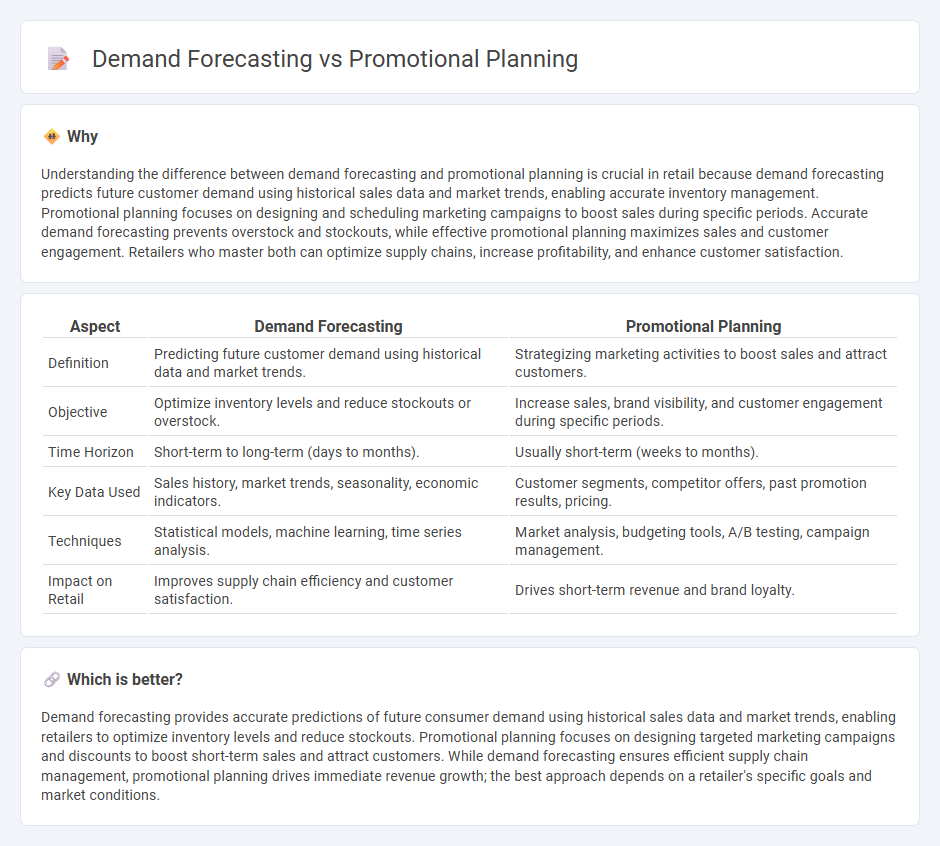
Demand forecasting analyzes historical sales data and market trends to predict future product demand, enabling retailers to optimize inventory levels and reduce stockouts. Promotional planning focuses on designing and scheduling marketing activities to boost sales during specific periods, aligning offers with customer behavior and business goals. Discover how integrating demand forecasting with promotional planning can maximize retail profitability and customer satisfaction.
Why it is important
Understanding the difference between demand forecasting and promotional planning is crucial in retail because demand forecasting predicts future customer demand using historical sales data and market trends, enabling accurate inventory management. Promotional planning focuses on designing and scheduling marketing campaigns to boost sales during specific periods. Accurate demand forecasting prevents overstock and stockouts, while effective promotional planning maximizes sales and customer engagement. Retailers who master both can optimize supply chains, increase profitability, and enhance customer satisfaction.
Comparison Table
| Aspect | Demand Forecasting | Promotional Planning |
|---|---|---|
| Definition | Predicting future customer demand using historical data and market trends. | Strategizing marketing activities to boost sales and attract customers. |
| Objective | Optimize inventory levels and reduce stockouts or overstock. | Increase sales, brand visibility, and customer engagement during specific periods. |
| Time Horizon | Short-term to long-term (days to months). | Usually short-term (weeks to months). |
| Key Data Used | Sales history, market trends, seasonality, economic indicators. | Customer segments, competitor offers, past promotion results, pricing. |
| Techniques | Statistical models, machine learning, time series analysis. | Market analysis, budgeting tools, A/B testing, campaign management. |
| Impact on Retail | Improves supply chain efficiency and customer satisfaction. | Drives short-term revenue and brand loyalty. |
Which is better?
Demand forecasting provides accurate predictions of future consumer demand using historical sales data and market trends, enabling retailers to optimize inventory levels and reduce stockouts. Promotional planning focuses on designing targeted marketing campaigns and discounts to boost short-term sales and attract customers. While demand forecasting ensures efficient supply chain management, promotional planning drives immediate revenue growth; the best approach depends on a retailer's specific goals and market conditions.
Connection
Demand forecasting analyzes historical sales data and market trends to predict future consumer demand, which directly informs promotional planning by identifying optimal timing and product focus. Precise demand forecasting reduces inventory risks and maximizes promotional effectiveness, driving increased sales and customer satisfaction. Efficient alignment of these strategies enhances supply chain management and boosts overall retail profitability.
Key Terms
Promotional planning:
Promotional planning involves strategizing marketing activities to boost product sales, targeting specific customer segments based on temporal factors and market trends. It relies on analyzing past campaign performance and consumer behavior to allocate budgets and select appropriate promotional channels effectively. Explore more insights on optimizing promotional planning to maximize ROI and market impact.
Campaign scheduling
Promotional planning centers on scheduling campaigns to maximize customer engagement and sales during key periods, utilizing historical sales data and market trends. Demand forecasting predicts future product demand by analyzing past sales, seasonal patterns, and external factors, enabling accurate inventory and resource allocation. Explore the strategic differences between campaign scheduling and demand forecasting to enhance your marketing effectiveness.
Offer strategy
Promotional planning focuses on crafting targeted campaigns that drive short-term sales spikes by leveraging discounts, bundles, and limited-time offers to boost customer engagement. Demand forecasting uses historical sales data and market trends to predict future product demand, ensuring optimal inventory levels and supply chain efficiency. Explore how integrating offer strategy with predictive analytics can enhance both promotional effectiveness and demand accuracy.
Source and External Links
Promotional Plan: Definition & Benefits - ActiveCampaign - A promotional plan is a strategic document detailing marketing activities and channels to promote a product or brand, designed to increase brand visibility and achieve marketing goals through focused activities, consistent messaging, targeted audience engagement, and optimized resource allocation.
Sales Promotion Planning: Step-by-Step Guide for Success | Opia - Sales promotion planning involves defining SMART goals, understanding the target audience, selecting promotion types, crafting messaging, choosing channels and timing, budgeting, risk assessment, executing, monitoring, and evaluating results for effective sales boosts.
Definitive Guide: What Is Promotional Planning? | Indeed.com - Promotional planning is a marketing tool to create structured promotional campaigns with set objectives, budgets, and themes to advertise products effectively and cohesively, ensuring alignment with business goals and brand recognition.
 dowidth.com
dowidth.com